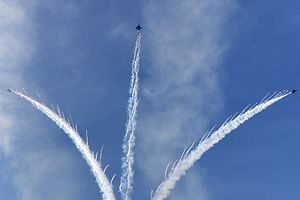On February 4, the head of the U.S. Air Force kicked off his introductory visit to Singapore. The trip, which included meetings with top defense officials from the city-state and attendance at this year’s iteration of the Singapore Airshow, reinforced the defense relationship between the two longtime strategic partners.
As I have noted before in these pages, the United States and Singapore have long viewed each other as vital strategic partners, and that extends to the security realm as well (“Strengthening the U.S.-Singapore Strategic Partnership”). The United States is a key supplier of defense technology and facilities for military training for Singapore, while the city-state is a valuable regional partner that across a range of issues from counterterrorism to maritime security while also hosting a U.S. Navy logistics command unit that coordinates regional operations.
Today, the two counties continue to interact regularly through a string of exchanges, exercises, and training opportunities. Defense ties were also part of the conversation during Singapore Prime Minister Lee Hsien Loong’s summit meeting with US. President Donald Trump back in October last year (See: “US-Singapore Defense Ties in the Spotlight Amid Trump-Lee Summit”), and Trump is expected to make his first visit to the city-state later this year in his current capacity as Singapore takes over the annually rotating chairmanship of the Association of Southeast Asian Nations (ASEAN).
On February 4, in another development that reaffirmed the importance of the bilateral relationship, U.S. Air Force Chief General David L. Goldfein kicked off his introductory visit to Singapore. Goldfein’s visit, his first since assuming the post in 2016, came following his trip to India where he had made headlines flying India’s indigenous light combat aircraft Tejas. His visit included meetings with top Singapore defense officials including Second Minister for Defense Ong Ye Kung, Chief of Defense Force Lieutenant-General Perry Lim, and Chief of Air Force Major-General Mervyn Tan.
Goldfein’s visit will also involve participating in the 2018 iteration of the biennial Singapore Airshow, which is the region’s biggest event of its kind. Though it is not uncommon for U.S. officials to attend these events, there has been attempts to highlight it more so this year under the Trump administration not just as part of U.S. defense policy but also Washington’s overall commitment to the region as well (See: “Trump’s Indo-Pacific Strategy Challenge”).
Officials have cited metrics that attest to the greater level of U.S. participation in SA18, including the number of exhibitors (over 170 compared to more than 140 in 2016) and also the new platforms being displayed. Ahead of SA18, Tina Kaidanow, the principal deputy assistant secretary in the State Department’s Bureau of Political-Military Affairs, had also characterized defense ties between the United States and Singapore as being very strong in a briefing to reporters, even though she predictably declined to comment on any further military sales to the city-state.
SA18 also holds greater significance for Singapore itself this year as well. Apart from the fact that the country holds the ASEAN chairmanship this year, SA18 kicks off a series of commemorative activities tied to the Republic of Singapore Air Force’s (RSAF’s) 50th anniversary, which are set to continue on for the better part of this year (See: “Singapore’s Air Force at 50”). During his visit to SA18, Goldfein was scheduled to tour the RSAF’s static display of aircraft and weapon systems and view exhibitions at the RSAF50 Pavilion.

































